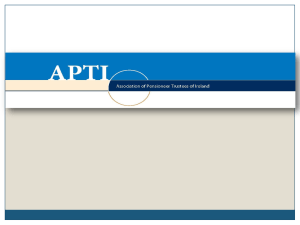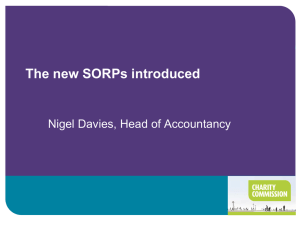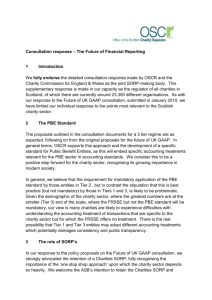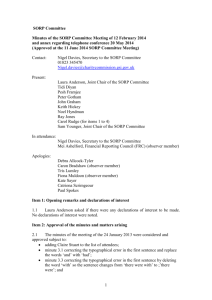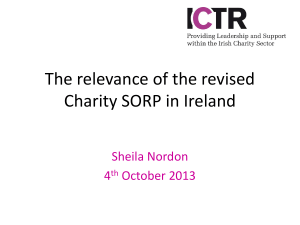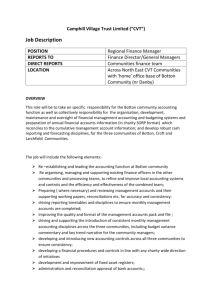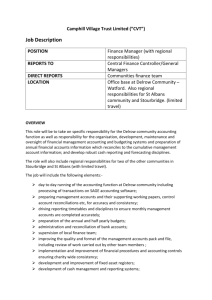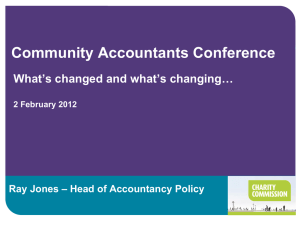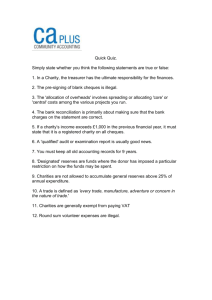SORP Committee
advertisement
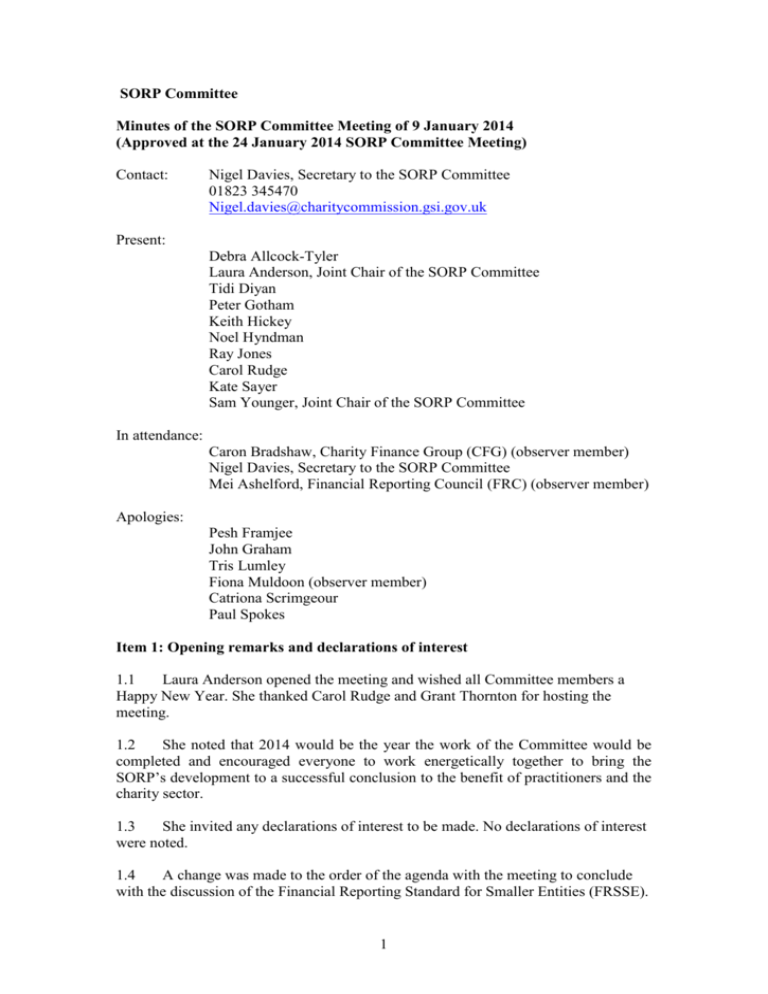
SORP Committee Minutes of the SORP Committee Meeting of 9 January 2014 (Approved at the 24 January 2014 SORP Committee Meeting) Contact: Nigel Davies, Secretary to the SORP Committee 01823 345470 Nigel.davies@charitycommission.gsi.gov.uk Present: Debra Allcock-Tyler Laura Anderson, Joint Chair of the SORP Committee Tidi Diyan Peter Gotham Keith Hickey Noel Hyndman Ray Jones Carol Rudge Kate Sayer Sam Younger, Joint Chair of the SORP Committee In attendance: Caron Bradshaw, Charity Finance Group (CFG) (observer member) Nigel Davies, Secretary to the SORP Committee Mei Ashelford, Financial Reporting Council (FRC) (observer member) Apologies: Pesh Framjee John Graham Tris Lumley Fiona Muldoon (observer member) Catriona Scrimgeour Paul Spokes Item 1: Opening remarks and declarations of interest 1.1 Laura Anderson opened the meeting and wished all Committee members a Happy New Year. She thanked Carol Rudge and Grant Thornton for hosting the meeting. 1.2 She noted that 2014 would be the year the work of the Committee would be completed and encouraged everyone to work energetically together to bring the SORP’s development to a successful conclusion to the benefit of practitioners and the charity sector. 1.3 She invited any declarations of interest to be made. No declarations of interest were noted. 1.4 A change was made to the order of the agenda with the meeting to conclude with the discussion of the Financial Reporting Standard for Smaller Entities (FRSSE). 1 Item 2: Approval of the minutes and matters arising 2.1 The minutes of the meeting of the 20 November 2013 were considered and approved. Item 3: Analysis of SORP responses 3.1 Nigel Davies introduced this item and noted that the papers would be taken in order with papers 2 and 2.1 taken together, followed by Paper 2.2 with any issues requiring further discussion carried over to Paper 2.3. He noted that the matter of how best the SORP can support users of the FRSSE was a later item on the agenda. 3.2 The range of categories of respondents and the number of responses received had been very encouraging. Overall there was strong support for the new format of the SORP which was also considered to offer greater support to smaller charities. It was also viewed as comprehensive in its treatment of charity reporting and accounting issues. The SORP micro-site had been well received. He noted that a considerable number of thoughtful changes had been offered and in particular there was a need to look again at how best to support the FRSSE option for accounts preparation. 3.3 The Committee discussed the categories of the respondents and noted that whilst smaller charities and trustees were well represented, the number of responses from funders and funding bodies was smaller than had been hoped. The Committee was reassured to note that responses had been received from umbrella bodies representing grant-making foundations and individual foundations. Also of the 26 events held, 2 specifically targeted funders. 3.4 The SORP research process provided further evidence as to the information sought by funders as had the 2012 IPSOS MORI research commissioned by the Charity Commission. However beneficiaries were not well represented. Despite the best of endeavours the SORP research process had shown that beneficiaries were a difficult group to reach and this had also been the case in the SORP consultation. Responses were received from 2 members of the public and 3 general users of charity accounts (DSC, legal firm Turcan Connell and one user of charity services). 3.5 The Committee considered papers 2 and 2.1. Although respondents were supportive of the approach taken to reporting performance, the reference to ‘impact reporting’ had drawn a mixed response and this needed further consideration. Although it was noted that the term ‘impact’ was used in the current SORP and was defined. 3.6 The Committee was pleased that the feedback about the simplifications made to the Statement of Financial Activities (SoFA) was very positive. Further simplifications to the revised format were recommended by the Secretariat. It was noted that some respondents had made further suggestions, including a single column SoFA, and that these were included in paper 2.3. Although in answer to question 9, the overwhelming response was that single column SoFA should not be mandatory, the requirement of FRS 102 to provide comparatives for all amounts shown on the face of the financial statements gave more weight to the case for a single column SoFA as an option that warranted further consideration. 2 3.7 In response to issues raised by respondents to question 10, the Secretariat had proposed some text giving guidance on accounting for UK retail gift aid schemes. The text needed further consideration as schemes were often undertaken through trading subsidiaries and agency fees could be substantial and were regarded as non-charitable trading for tax purposes. 3.8 However, the key issues for accounting guidance on retail gift aid schemes was the point at which the income from the sale should be recognised and in which income category of the Statement of Financial Activities (SoFA) the income from fees and the receipt of the donation should be presented. Although charities with historical data might wish to apply a formula to proceeds received in the last month of the reporting period to address the uncertainty, if any, of the sale proceeds being donated, strictly speaking 21 days had to elapse and consent had to be received before the proceeds could be legally regarded as a donation. The question was whether the point of sale or the point at which the charity was legally entitled to the proceeds should be taken as the recognition point for income purposes. 3.9 The Committee noted that the responses to question 11 mirrored some of the debates that the Committee had had when discussing the extent of disclosures by grant-makers of grants made to institutions. The importance of having information publicly available on grants made to institutions was acknowledged but in light of the feedback of the responses received it was appropriate to reinstate the option to disclose a list of grants separately from the accounts. Although a concern was raised about whether such lists would be subject to the same audit scrutiny as when they are presented in accounts. The Committee was disappointed to note that the Directory of Social Change had indicated that charities currently taking this option had often failed to provide the information when requested but arguably withdrawing a useful option for all grant-makers due to the behaviour of a few might not be appropriate at this stage. 3.10 The Committee noted that in the light of the strength of views expressed in answer to question 12 on the disclosure by all larger charities of the post and pay of the highest paid member of staff, the disclosure of executive remuneration is a topic taken forward by Paper 2.3 as an issue for further discussion. 3.11 Questions 17 and 18 dealt with mixed motive investments with majority support for the accounting treatment proposed in the Exposure Draft SORP. The Committee noted that the use of these investments was at an early stage and that a future SORP Committee might usefully return to this topic in the light of developing sector experience of these investments. 3.12 Although the majority of responses to question 19 supported the exclusion of corporate charities from being treated as incorporated branches, it was noted that a significant number of responses advocated the treatment of corporate charities as branches. The two main reasons advanced were the requirement in some overseas jurisdictions to establish incorporated charities and the consent of the Charity Commission to making linking directions for corporate charities. On the second point, he noted that the respondents were in error as the relevant operational guidance (OG 555 Linking Directions) required consolidated accounts to be prepared in these circumstances. 3 3.13 The Committee noted that only three of the respondents had provided an alternate definition of branches, two responses had advocated the extension of the definition of special trusts found in the Charities Act 2011 and one had argued that the ‘true and fair’ over-ride could be applied. It was noted that the Charities Act 2011 response was jurisdiction specific and did not readily apply outside of England and Wales. It was also pointed out that commercial entities also operated through both branch and subsidiary structures and no corresponding argument has been put forward for the inclusion of overseas subsidiaries as part of the parent company’s own balance sheet. 3.14 The Committee debated the nature of control and noted that in the case of branches control is direct, as the branches directly report into the charity’s management structure, whereas in the case of subsidiaries control is exercised indirectly via the voting rights of equity or as a result of appointing directors or trustees to the board of the subsidiary. 3.15 The results of a corporate charity controlled by the reporting charity has to be included in the combination whether treated as a branch or a subsidiary and therefore has no impact on the accounts of the overall combination taken together. However, it was noted that there might be a reluctance to change accounting policies where a corporate subsidiary has previously been included in the parent entity’s balance sheet as this would involve a restatement of prior periods. The effect of treating a corporate charity as a subsidiary rather than a branch is to diminish the relative size of the reporting charity relative to its subsidiaries. It was considered that in the case of consolidated accounts, the user place most emphasis on the consolidated accounts rather than the parent entity’s balance sheet in any event. The Committee considered that a sufficient case to treat corporate charities as branches had not been made. It noted that in exceptional circumstances, the substance over legal form argument that justifies a ‘true and fair’ over-ride can always be applied. 3.16 Whilst agreeing that the disclosure of all ex-gratia payments should be reinstated in response to feedback from funders to question 23, the Committee argued that a threshold of ‘significant’ show be applied to avoid small gifts of flowers or cash honoraria being disclosed. It was noted that the SORP used ‘materiality’ differently in the context of related party transactions and a discussion as to whether more guidance might be given on materiality was needed. 3.17 Nigel Davies introduced Paper 2.2 which considered ideas for changes to the SORP which had significant support from respondents to the consultation. He noted that a number of these suggestions had been considered already in the discussion of Papers 2 and 2.1. Some suggestions were held over due to the diversity of opinion as topics for further discussion and were included within Paper 2.3. Suggestions as to how best to support the FRSSE were taken as a separate item on the agenda. Only those modules which attracted significant comment were reviewed in Paper 2.2. 3.18 In introducing Paper 2.2, it was noted that particular attention is given to views of professional bodies, umbrella bodies and funders when considering any changes to the Exposure Draft SORP. A number of respondents had helpfully identified typographical errors or changes needed for technical clarity in the SORP and the Paper listed these and the action taken. 4 3.19 The Committee then reviewed Paper 2.2 and considered the suggestions made by respondents and the proposed action, if any, recommended by the Secretariat. 3.20 When considering module 18, heritage assets, the Committee noted that depreciated replacement cost was not a feasible option when a replacement could not be created either because the technique, materials, or know-how had been lost or the origin of the item was the key to its character, therefore a flexible approach was needed to any valuation model. The Committee agreed that the SORP should restrict itself to the definition found in FRS 102 and so reference to a charity’s purposes was not necessary. 3.21 In concluding the discussion, the Committee thanked Nigel Davies for the thorough and comprehensive analysis he had provided of the responses to the SORP consultation exercise. 3.22 It was decided that the actions proposed by the Secretariat to be taken in light of the responses to the 25 consultation questions have the support of the Committee, subject to the following points: Kate Sayer would e-mail to the Secretariat a suggested approach for the accounting treatment of income receivable under the UK retail gift aid scheme. Two topics: performance reporting and materiality should be added to the topics covered by Paper 2.3. The option to disclose a list of institutional grants separately from the accounts should be reinstated but the option must be restricted to those grant-makers with a website and the note to the accounts should require details of the website home-page and require the total of the list of grants to reconcile to the total in the accounts. 3.23 It was agreed that all the suggestions made by the Secretariat in Paper 2.2 be accepted except for: Committee members to advise the Secretariat of any suggestions in the responses as to points of technical clarity that they consider have been overlooked. In module 1, the disclosure of risk by larger charities remains a ‘must’ and be aligned with the requirements of the Strategic Report. In module 1, the inclusion of ‘activities’ with ‘activities, achievement and performance’ only proceed if compatible with the requirements for the Strategic Report. In module 9 the text should clarify that disclosure of termination and redundancy pay is in total only. In module 18 in addition to deleting paragraph 18.10 and the preceding heading, the text ‘where their preservation and contribution to culture are ancillary to faith or other purposes’ be deleted. In module 21, the alignment of definitions of mixed motive investments with Charity Commission guidance CC14 only proceed if compatible with other jurisdictions covered by the SORP. In the glossary, the definition of a general volunteer should only exclude volunteering in relation to their own trade or profession. 5 Item 4: Issues for discussion at the next meeting 4.1 The topics considered by Paper 2.3 were approved and the following additional points are to be added: A discussion of impact reporting. A discussion of the term ‘materiality’. 4.2 The discussion of Paper 2.3 to be held over until the next meeting with those members unable to attend that meeting circulating their views to all members of the Committee by e-mail beforehand. Item 5: Update from the FRC 5.1 Mei Ashelford advised that the future of the FRSSE was the main issue relevant to the Charities SORP. She noted that discussion was on-going with the Department of Business Innovation and Skills regarding the timing of implementation of the new European Accounting Directive. It was anticipated that the changes would come into effect on a mandatory basis for accounting periods beginning 1 January 2016 and that affected companies could adopt it early for financial periods beginning 1 January 2015. 5.2 The normal development process for a new standard took at least 9 to 12 months, but in order to facilitate early adoption from 2015, a solution would need to be developed in 2014 to support companies reporting on the new basis. Two options were under consideration by the FRC, a new FRSSE (based on the recognition and measurement requirements of FRS 102 but with simplifications) or to withdraw the FRSSE and require all entities to apply FRS 102 (with amendments to dis-apply those disclosures not permitted by the Accounting Directive). 5.3 A new FRSSE would only be appropriate if different measurement and recognition bases were to be used by smaller companies, otherwise a solution based on FRS 102 would be more appropriate. She noted that the turnover criterion for a small company was likely to increase from £6.5m to £10.1m. She invited the Committee to express their views. 5.4 It was noted that the current FRSSE, derived from old GAAP, did not require the accrual of a liability for additional agreed payments to make a good a deficit on a defined benefit pension scheme or require any related disclosure. This was potentially a significant reason why many preparers would wish to stick with the current FRSSE. Harmonisation around new GAAP FRS 102 would remove this and other dissimilarities in measurement and recognition bases. It was also noted that reference needed to be made to accepted or current practice for issues not addressed in the standard and therefore the FRSSE was not really a standalone standard nor did it address key PBE accounting issues. 5.5 A majority of the Committee favoured a single regime based on FRS 102 with reduced disclosures required of those entities eligible for the small company regime. It was noted that it would fall to a future SORP Committee to consult on which, if any, disclosures dis-applied for smaller companies should be retained for charities in the public interest to meet the needs of funders, donors and users of charity accounts. 6 5.6 In conclusion, she noted that the Code of Practice for SORP is to be changed. The amendments to the Code clarify that the scope of the FRC’s review (and approval) is limited to information pertaining to the financial statements and that consultation responses would need to be posted on the web within 10 days of their receipt rather than the timing being at the discretion of the SORP making body. Item 7: Information Sheet: Strategic Review 7.1 Ray Jones introduced this item and thanked Claire Stuart for her assistance in developing the new Information Sheet. He noted that new regulations made under the UK Companies Act required medium and large companies to provide a Strategic Report. The accepted view, agreed with BIS, was that a Strategic Report could be provided as a distinct section of the Trustees’ Annual Report. 7.2 The practical effect of the regulations was to draw together a number of existing parts of the trustees’ annual report into a separate section which will need to be labelled as a Strategic report. Also the trustees’ statement of approval of the trustees’ annual report must make separate mention of the Strategic Report. 7.3 Mei Ashelford confirmed that FRC approval was not required for the guidance as it dealt with narrative reporting rather than an accounting issue. She would however arrange for any drafting comments from FRC staff leading on this issue to be forwarded. 7.4 The Committee welcomed the Information Sheet and asked that it be published on the web as soon as practicable. Item 6: SORP and the FRSSE 6.1 Ray Jones introduced this item. He noted that new FRSSE or a small entity version of FRS 102 is likely to be issued in late 2014 and that this would necessitate further revision of the SORP. It was prudent to plan now for these developments and consider how they can best be accommodated with the impact on non-FRSSE users minimised as far as possible. 6.2 He noted that the draft SORP’s approach for dealing with the FRSSE would now have at best a single year’s life before change was essential. Indeed, there would be pressure to amend the new SORP immediately following it implementation on 1 January 2015. The advantages of two SORP approach, one to support the FRSSE and one to support FRS 102 was that FRS 102 users would not be disrupted by changes to the FRSSE regime. Moreover, it would also address concerns raised in consultation that the draft SORP was slanted towards FRS 102 users and would facilitate identifying the distinction between the requirement of the SORP and standards. He noted that although accounting treatments were effectively often the same, however the FRSSE used different terminology to that of FRS 102 and measurement bases differed somewhat as did disclosures. The FRSSE also had many gaps, not least regarding aspects of charity and not-for profit accounting and the SORP would still need to fill in those gaps for FRSSE users. The risk with this approach is that the two SORP might look very similar and we risk be accused of saying the same thing in a slightly different manner. 7 6.3 It was anticipated that an initial draft FRSSE SORP would be available for the next meeting of the SORP Committee. If agreed in time this would allow two SORPs to be submitted to the FRC in March, one solely referring to FRS 102 and the other to the FRSSE. The FRC had advised that a consultation on a FRSSE SORP was not necessary provided the agreed changes reflecting the consultation responses to do with relevant non-FRSSE items are made any other changes are solely to reflect the terminology and differing measurement bases of the FRSSE. 6.4 It was noted that an advantage of a two SORP approach is the FRS 102 SORP could readily be amended if required to accommodate any changes made by the FRC following implementation of the Accounting Directive. 6.5 It was agreed that the SORP making body would aim to submit a FRSSE SORP for consideration at the next SORP Committee. It was noted that this first draft version would subsequently be amended to reflect the actions already agreed following the review of the responses to the consultation on the Exposure Draft SORP and any future actions agreed when Paper 2.3 is considered. Item 8: Any other business 8.1 The Committee noted that the new SORP(s) were to be submitted to the FRC in March and agreed to provisionally timetable a meeting for the end of March. A final meeting of the SORP Committee is to take place in June prior to the publication of the new SORP(s) after which the current SORP Committee will be stood down. 8.2 There being no other business the meeting closed. 8
